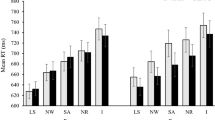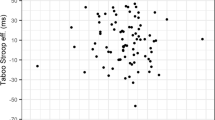Abstract
One of the main features of the attentional system is the capability to select between relevant and irrelevant information. However, irrelevant information interferes with the processing of the relevant one. Using high-field magnetic resonance imaging, we examined the interference effect of a verbal (color-word) and a spatial (arrow-position) Stroop task on the activation of cortical areas known to be dedicated to the attentional control. Behaviorally, we found costs from the irrelevant information in both tasks; in the brain, we found a common neural network of activation that mainly involved the dorsolateral prefrontal cortex and the anterior cingulate cortex. However, the neural circuits involved in the two tasks overlapped only partially, since processing of words in the color-word Stroop task showed a wider and more right-lateralized activation, while spatial processing in the arrow-position Stroop task resulted in a more restricted and left-lateralized activation.





Similar content being viewed by others
Notes
Lateralization is discussed only qualitatively.
References
Banich MT, Milham MP, Atchley R, Cohen NJ, Webb A, Wszalek T, Kramer AF, Liang ZP, Wright A, Shenker J, Magin R (2000) fMRI studies of Stroop tasks reveal unique roles of anterior and posterior brain systems in attentional selection. J Cogn Neurosci 12:988–1000
Banich MT, Milham MP, Jacobson A, Cohen NJ, Webb A, Wszalek T, Kramer AF, Liang ZP, Barad V, Gullett D, Shah C, Brown C (2001) Attentional selection and the processing of task-irrelevant information: insights from fMRI examinations of the Stroop tasks. Progr Brain Res 134:459–470
Barch DM, Braver TS, Sabb FW, Noll DC (2001) Anterior cingulate and the monitoring of response conflict: evidence from an fMRI study of overt verb generation. J Cogn Neurosci 12:298–309
Belanger HG, Cimino CR (2002) The lateralized Stroop: a meta-analysis and its implications for models of semantic processing. Brain Lang 83:384–402
Bench CJ, Frith CD, Grasby PM, Friston KJ, Paulesu E, Frackowiak RS, Dolan RJ (1993) Investigations of the functional anatomy of attention using the Stroop test. Neuropsychologia 31:907–922
Botvinick MM, Cohen JD, Carter CS (2004) Conflict monitoring and anterior cingulate cortex: an update. Trends Cogn Sci 8:539–546
Brown JW, Braver TS (2005) Learned predictions of error likelihood in the anterior cingulate cortex. Science 307:1118–1121
Carter C, Mintun M, Cohen JD (1995) Interference and facilitation effects during selective attention: an H 152 O PET study of Stroop task performance. Neuroimage 2:264–272
Faccioli C, Peru A, Rubini E, Tassinari G (2008) Poor readers but compelled to read: Stroop effects in developmental dyslexia. Child Neuropsychol 14:273–283
Fan J, Flombaum JL, McCandliss BD, Thomas KM, Posner M (2003) Cognitive and brain consequences of conflict. Neuroimage 18:42–57
Glover GH (1999) Deconvolution of impulse response in event-related BOLD fMRI. Neuroimage 9:416–429
Leung HC, Skudlarski P, Gatenby JC, Peterson BS, Gore JC (2000) An event-related functional MRI study of the Stroop color-word interference task. Cereb Cortex 6:552–560
Liu X, Banich MT, Jacobson BL, Tanabe JL (2004) Common and distinct neural substrates of attentional control in an integrated Simon and spatial Stroop task as assessed by event-related fMRI. Neuroimage 22:1097–1106
MacDonald AW 3rd, Cohen JD, Stenger VA, Carter CS (2000) Dissociating the role of the dorsolateral prefrontal and anterior cingulate cortex in cognitive control. Science 288:1835–1838
MacLeod CM (1991) Half a century of research on the Stroop effect: an integrative review Psychol Bull 109:163–203
Milham MP, Banich MT, Webb A, Barad V, Cohen NJ, Wszalek T, Kramer AF (2001) The relative involvement of anterior cingulate and prefrontal cortex in attentional control depends on nature of conflict. Cogn Brain Res 12:467–473
Milham MP, Banich MT, Claus ED, Cohen NJ (2003) Practice-related effects demonstrate complementary roles of anterior cingulate and prefrontal cortices in attentional control. Neuroimage 18:483–493
O’Leary Mj, Barber PJ (1993) Interference effects in the Stroop and Simon paradigms. J Exp Psychol Hum Percept Perform 19:830–844
Pardo JV, Pardo PJ, Janer KW, Raichle ME (1990) The anterior cingulate cortex mediates processing selection in the Stroop attentional conflict paradigm. Proc Natl Acad Sci USA 87:256–259
Roberts KL, Hall DA (2008) Examining a supramodal network for conflict processing: a systematic review and novel functional magnetic resonance imaging data for related visual and auditory stroop tasks. J Cogn Neurosci 20:1063–1078
Talairach J, Tournoux P (1988) Co-planar stereotactic atlas of the human brain, 2nd edn. Thieme, Stuttgart
Turken AU, Swick D (1999) Response selection in the human anterior cingulate cortex. Nat Neurosci 2:920–924
Turner R, Howseman A, Rees GE, Josephs O, Friston K (1998) Functional magnetic resonance imaging of the human brain: data acquisition and analysis. Exp Brain Res 123:5–12
Ullsperger M, von Cramon DY (2001) Subprocess of performance monitoring: a dissociation of error processing and response competition revealed by event-related fMRI and ERPs. Neuroimage 14:1387–1401
van Veen V, Cohen JD, Botvinick MM, Stenger VA, Carter CS (2001) Anterior cingulate cortex, conflict monitoring, and levels of processing. Neuroimage 14:1302–1308
Wager TD, Sylvester CY, Lacey SC, Nee DE, Franklin M, Jonides J (2005) Common and unique components of response inhibition revealed by fMRI. Neuroimage 27:323–340
Wang C, Ulbert I, Schomer DL, Marinkovic K, Halgren E (2005) Responses of human anterior cingulate cortex microdomains to error detection, conflict monitoring, stimulus-response mapping, familiarity, and orienting. J Neurosci 25:604–613
Zysset S, Müller K, Lohrmann G, von Cramon DY (2001) Color–word matching Stroop task: separating interference and response conflict. Neuroimage 13:29–36
Author information
Authors and Affiliations
Corresponding author
Rights and permissions
About this article
Cite this article
Zoccatelli, G., Beltramello, A., Alessandrini, F. et al. Word and position interference in stroop tasks: a behavioral and fMRI study. Exp Brain Res 207, 139–147 (2010). https://doi.org/10.1007/s00221-010-2433-x
Received:
Accepted:
Published:
Issue Date:
DOI: https://doi.org/10.1007/s00221-010-2433-x




